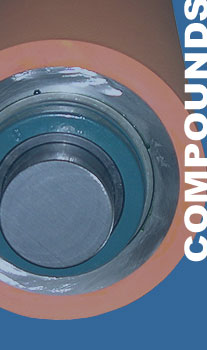

|
SBR - has good abrasion resistance, durability, load bearing characteristics, impact, cut and gouge resistance. It is a great economical solution for many applications. Natural Rubber - has some outstanding properties such as: resistance to polar solvents, outstanding resiliency, cost-effectiveness and abrasion resistance. In its natural state (low durometer 40-50A) is referred to as Gum Rubber. Nitrile - also known as NBR or Buna-N. Nitrile physical properties include high resiliency, abrasion resistance and good general resistance to solvents, oil and water. Because of its physical properties, chemical resistance and cost-efficiency nitrile is a good choice for various applications. Carboxylated Nitrile - modified Nitrile rubber, possessing most of nitrile’s properties along with outstanding abrasion resistance, tear and load bearing properties and oil resistance. Neoprene - a good choice for general-purpose applications. It has good mechanical properties, chemical resistance and high resilience. This compound is generally referred to as Chloroprene. AquaFlex™ - in applications where rolls come into contact with aggressive, hot aqueous media such as high pH (caustic solutions), these compounds will outlast typical formulations by as much as 2 to 1. EPDM - typically used where its chemical resistance and temperature tolerance are required. A balance of physical properties and chemical resistance makes it ideal for a wide variety of rubber applications. Often used in harsh chemical and high temperature (up to 325 F continuous) applications. Millable Urethane - a synthetic rubber that is processed on typical rubber processing equipment. It has extremely good wear resistance and excellent solvent resistance. This compound offers the benefits of rubber and the durability of urethane. Cast Urethane - the only material that has a combination of the following properties: strength, resilience, abrasion resistance and good load bearing characteristics. Urethane is available in two chemical types: ester (tough elastomer with good chemical and solvent resistance) and ether (works better in applications that come in contact with water). Hypalon - used extensively in the industry because of its broad range of valuable properties which include ozone, abrasion resistance, very good chemical resistance, tensile and tear strength. Silicone - well suited for applications requiring a balance of heat and release properties. Silicone is known for two main attributes: high temperature resistance and excellent release properties. Other features include good chemical resistance and excellent ozone resistance. Fluoroelastomer (Viton) - offers an extraordinary level of resistance to chemicals, oils and heat. Used in a wide variety of high performance applications where premium performance and long-term reliability, even in harsh environments, are required. This compound has very good release properties. Teflon® - has exceptional resistance to high temperatures, harsh chemicals, corrosion, stress-cracking and has very good low-temperature characteristics. Properties of Teflon® make it the perfect material for various industrial applications and different processing techniques. Teflon® has exceptional release properties. Static dissipative/antistatic compounds - rubber compounds can be formulated in a wide range of electrical resistances from highly conductive to highly resistive, depending on the characteristics of their compounding ingredients. Antistatic rollers are used to avoid two main problems:
* Please note this list is for reference purposes only. The descriptions contain basic properties and attributes associated with generically named compounds. Furthermore, the list of compounds is not exclusive and special blends can be compounded to suit unique, specific application requirements. Design and application for the purposed use lies with the end user. |
